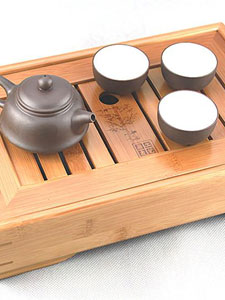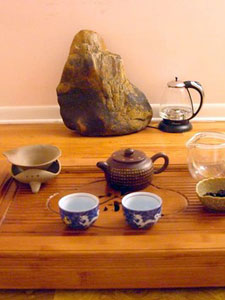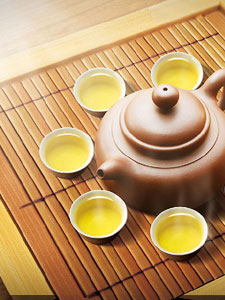Gong Fu Ceremony



Gong fu means the art of doing something well. In the tea ceremony known as gong fu, the implication is that time, dedication and effort will produce an ultimate tea experience. The phrase is also spelled as kung fu, kung fu-cha or gong fu-cha.
Gong fu is a formal Chinese tea ceremony, albeit less so than Japanese chanoyu. A specialty of Fukien, a major oolong tea-producing area in mainland China, it has become a signature tea service in the Republic of China (aka Taiwan and formerly known as Formosa). When politics impacted Fujian centuries ago, many tea manufacturers moved from there to Formosa and brought both their oolong tea growing skills and tea ceremony to the island country.
Although there are many steps in the gong fu tea ceremony, they are easy to master and they rarely take more than ten minutes to perform. Guests usually number two to four.
Accoutrements
Perforated wooden or metal tray: holds all the accoutrements. Its holes allow the drips of water to flow through onto a tray beneath to catch inevitable spills.
Bamboo Tools: critical to avoid fingers or hands touching the tea leaves and spoiling them with sweat, oils or scent from our skin. Stored in a cylindrical bamboo vase, they include a scoop for measuring tea, tongs for lifting the small cups and fragrance cups, plus a tea needle. The tea needle has one pointed end to clear leaves from the teapot spout and a blunt spatulated end to scrape leaves from inside the teapot after brewing is completed. A wooden "collar" may be included; it is set into an open teapot when the leaves are poured in and protects the leaves from falling onto the serving tray.
Caddy: holds tea leaves; preferably bamboo, porcelain bowl or lacquered tin. Store tea in these only for tea brewing and return leaves to their original packaging after the ceremony to retain the freshness of the tea.
Terrycloth or linen towel: to wipe the bottom of the teapot after warming it with water. It should be folded neatly and placed near the wooden tray.
Hot water: for washing the tea, cup and teapot. Tea kettle for heating the water for washing cups and pot, brewing the tea and to keep the water warm for additional pourings.
Small pitcher for the heated water to be poured into the teapot (rather than pouring the water directly from the kettle to the teapot.) May also be used to pour all the brewed tea into it so that the cups may be filled from this tea jug. This further insures that the tea is the same strength in color and flavor for each guest.
Teapot and cups. These are porcelain, glass or Yixing clay and very small. The teapots are about 3" in diameter and cups are about l" in diameter. Some sets come with saucers (cup plates), but are not necessary.
A Formal Gong Fu Setting
All the accoutrements and tea should be set out all at once. First, boil the water to wash the pot. Fill the teapot completely with the hot water and put on its lid. Use your index finger to hold the lid and your thumb and other fingers to hold onto the handle of the teapot. Fill each of the cups by slowly pouring the water into the cups from left to right and right to left until the cups are full and the teapot is emptied. Using the tea tongs, lift up the first cup and gently pour out the water into the next cup which will cause the water to spill over thus warm the outside of the cup. Repeat until all the cups are emptied. If you're ambidextrous or adventurous, you can use two tongs, one in each hand, and do this part in half the time!
Brewing the Tea
Heat spring water to the appropriate temperature: 195 degrees F for Ti Kuan Yin and lightly processed oolongs, which are greener in flavor character. Try 212 degrees F, or boiling, for darker oolongs. It is customary to offer an open bowl or caddy with the dry leaves for your guests to inhale its aroma. Using the bamboo scoop, measure out the tea and show the guests before slowly pouring the leaves into the teapot. Quantity varies, but a heaping teaspoon for a small pot should be enough. Pour the leaves as much in the center of the pot as possible.
Pour boiled water in a circular motion around the inside of the pot then into the center of the pot, moving the water pitcher up and down three times as a gesture for "three welcoming bows" to your guests. Pour no higher than 2-3" above the pot to avoid cooling the water. Fill the pot to the brim and replace the lid. Very quickly pour water into the cups back and forth as you did before, then discard this water completely. This first pouring, "foot water," is not suitable for drinking. Its purpose is to wash the tea of its dust and impurities and to awaken the leaves.
Immediately pour freshly boiled water onto the just-washed leaves in the same manner, around the inner edges and then up and down three times in the middle until the pot is filled to the brim. Replace the lid and pour water on the outside of the teapot to clean and warm it. Brew for two to five minutes, according to the vendor's suggestions. Oolong tea leaves are quite large; brewing them in such a small pot is what makes the resulting tea liquor intensely flavorful and fragrant.
Pick up the teapot and use the cloth to wipe its base then return the towel to its place next to the tray. Pour the tea starting at one end of the row of cups and pour back and forth but not to the brim (or they will spill when lifted to be drunk). This provides tea with a similar temperature and strength for each cup. Should the flow of the tea be interrupted, use the tea needle to dislodge any leaves.
When the teapot is empty, immediately pour on more hot water to the brim and brew. By initiating the second infusion immediately, it will be ready when your guests have finished their first thimble cup of tea. The second brew may require an additional minute or two.
Serving the Tea
If using saucers, use one hand to hold the saucer and the thumb and forefinger of your other hand to place the cup on the saucer. Serve the guest who will take the saucer with both hands. If not using saucers, use one hand on the bottom of the cup and your thumb and forefinger of the other hand on the sides of the cup and hand it to your guest. They should receive it in the same way.
Another way to serve is to gesture to the row of cups and have your guests pick them up themselves. At this point, the guests should first admire the color and fragrance before tasting. When they are through, they can place their cups on the tray for you to pour out the tea again. It is typical that high-quality oolongs offer at least three and sometimes four or more infusions using the same leaves. Each subsequent infusion time may add one or two minutes.
Should you like to offer a second type of tea for tasting to the same guests, wait about a half-hour. During this time, tea snacks, dim sum or similar "finger foods" may be offered while you either produce a second set of accoutrements or wash these (with hot water only) and dry them for the next tea service.
 teaclass
teaclass
